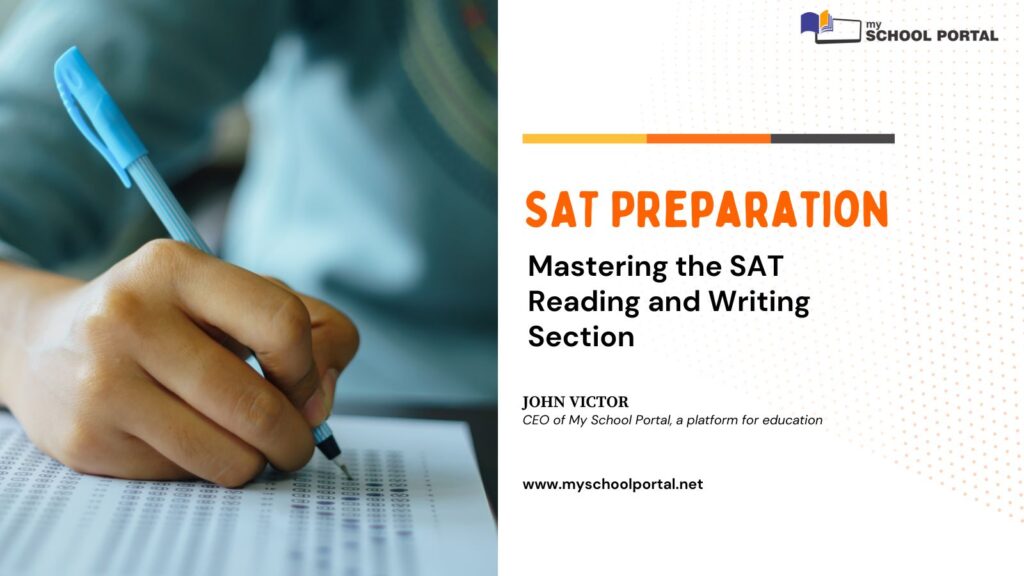The SAT Reading and Writing section might feel overwhelming at first glance, especially with the digital version of the test now in play. With over 50 passages to read and analyze in just 64 minutes, you’ll need a solid strategy to perform your best. But don’t worry—I’ve got you covered! In this guide, I’ll walk you through how the section works, the different question types, and proven strategies to help you approach those passages with confidence.
What to Expect From the SAT Reading and Writing Passages
In the digital SAT, you’ll encounter 55 passages—one for each of the 54 questions and an additional “cross-text” connections question, where you’ll compare two passages. These passages come from a mix of subjects, like literature, history, science, and the humanities, including some poetry from the early 1900s or before.
But here’s the catch—the passages are shorter now, ranging from just 25 to 150 words. While they’re brief, they pack a punch, requiring a higher level of reading comprehension. You’ll also see graphs and tables mixed in, so don’t be surprised if you’re asked to interpret data.
The key to acing this section lies in understanding the four main types of questions you’ll face, each testing a different skill:
- Information and Ideas (12–14 questions): You’ll need to pull details from texts or infographics to answer questions about main ideas, evidence, and logical inferences.
- Craft and Structure (13–15 questions): Here, you’ll interpret word meanings, analyze arguments, or evaluate ideas across passages.
- Expression of Ideas (8–12 questions): These questions test your ability to select transitions or revise sentences to improve clarity.
- Standard English Conventions (11–15 questions): Think grammar! These questions ask you to apply conventional grammar rules, such as punctuation or sentence structure.
Breaking Down the Different SAT Question Types
Within those four categories, you’ll face 11 specific types of questions. Some examples include:
- Command of Evidence: These questions ask you to find the strongest evidence in a passage that supports a specific claim.
- Words in Context: You’ll identify the most precise word or phrase based on how it’s used in a passage.
- Cross-Text Connections: You’ll read two passages and compare the authors’ perspectives.
And that’s just the beginning! Understanding how to tackle these specific questions will be key to improving your score.
Four Steps for Reading SAT Passages Efficiently
So, how do you make sense of all these passages and questions in the limited time you have? Here’s a simple four-step process you can follow every time:
- Decide If You’ll Read the Passage or Question FirstSome students like to read the passage thoroughly before answering questions, while others prefer reading the questions first to know what to look for. There’s no right or wrong way—just find what works best for you by practicing! Personally, I find that skimming the passage first gives a good sense of the main idea, then reading the questions helps focus on specifics.
- Understand What the Question Is AskingThe SAT loves to use tricky wording. Pay attention to details like words such as “except,” “not,” or “only.” Misreading one small word can cause you to miss the entire point of a question! Read carefully and break the question down if necessary.
- Find Key Information in the PassageWhen reading the passage, focus on the most important details. Look for transitional words like “however” or “despite,” which often signal important shifts in the argument. For cross-text questions, always look for points where the authors agree or disagree. Charts and graphs? Take a moment to really understand them because they will be key to answering the question.
- Back Up Your Answer With EvidenceThis is a critical step. Every answer you choose should have solid evidence from the passage to back it up. Don’t just pick an answer that feels right—go back and confirm that the text supports your choice. That extra step of double-checking can save you from falling into an SAT trap.
Pro Tips for Boosting Your SAT Reading and Writing Score
Beyond mastering these strategies, there are a few extra tips that can take your performance to the next level:
- Eliminate Wrong Answers First: Some answer choices will seem close to correct, but the SAT often includes answers that are too extreme or overly specific. Eliminate these and narrow your options. Avoid answers that contain words like “always” or “never”—they’re rarely right!
- Get Comfortable with Data: SAT questions often include graphs or tables, and practicing with similar data questions (like those in ACT Science) can improve your ability to analyze them quickly.
- Brush Up on Literary Terms: While the SAT isn’t a literature exam, you should still be familiar with basic literary devices, such as tone, theme, and imagery. Knowing these terms will help you recognize their use in passages and answer questions more accurately.
By practicing these strategies, you’ll feel much more confident tackling the SAT Reading and Writing section. Remember, it’s all about consistency—keep practicing, learn from your mistakes, and stay focused. With the right approach and enough preparation, you can absolutely ace this section!
Good luck! You’ve got this!
Related
Stay updated with the latest student resources and insights from My School Portal! Subscribe to our newsletter for fresh content delivered straight to your inbox—no spam, just value 😊














